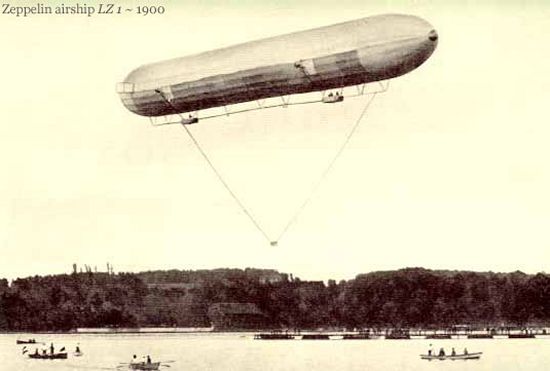|
||||||||||
|
|
||||||||||
|
||||||||||
|
|
||||||||||

What sets lighter-than-air and heavier-than-air travel apart is the method that makes flight possible. Heavier-than-air vehicles include craft like the airplane, glider, and helicopter. These vehicles are governed by aerodynamics, or the motion of air over a surface to create lift. By contrast, the flight of lighter-than-air vehicles like the balloon and airship is made possible by aerostatics. At the heart of aerostatics is the principal of buoyancy, or the tendency to float on or rise up through a fluid like water or air. To understand buoyancy, one must realize that the pressure within a fluid increases with depth. This principal is true both in liquids, like the ocean, and in gases, like the atmosphere. If you were to go scuba diving, you'd find that the pressure the water exerts on you increases the deeper you dive. The same effect occurs on a skydiver jumping from high altitude. This difference in pressure is due to the weight of the fluid pressing down on you as depth decreases. The deeper you go, the more fluid is overhead, the greater the weight of that fluid becomes, and the higher the pressure.
Another key property that is affected by depth is density, or the mass of the fluid that occupies a given volume. Water is incompressible, meaning that its density is a constant no matter how deep you go. Air, on the other hand, can be compressed. We have already established that the lower you go in the atmosphere, the greater the weight of the air pressing down on you becomes. As that pressure increases, the air becomes compressed to a higher density. We can see these trends in the following graph that shows how both pressure and density decrease as altitude increases. For example, both pressure and density are roughly half as high at an altitude of 20,000 ft (6,100 m) as they are at sea level.

By understanding the behavior of pressure and density in the atmosphere, we can see how balloons work. These vehicles are filled with a gas, like hot air or helium, that is lighter than the surrounding air and has a density lower than atmospheric density at sea level. When the balloon is filled with this light gas, it pushes a given volume of air out of the way. This volume of air has a certain weight, and the weight of the air that is "pushed out of way" by the balloon is called the displacement. Ships and boats operate in the same manner, except that they push out a certain weight of water in order to float. It is for this reason that the size of a ship is usually measured in displacement, or the weight of the water that is displaced by the ship's hull.
Getting back to our balloon, the fact that the gas inside the balloon is lighter than the surrounding air causes it to rise. However, it cannot continue rising forever because the density of the surrounding air is decreasing. Once the balloon reaches the altitude at which the density of the gas within is the same as the density of the external atmosphere, the balloon will stop climbing and float in the same location. If there is no other force acting on the balloon, like the wind, then it will stay in place because its weight is perfectly balanced by the atmospheric pressure acting on it. It is for this reason that a balloon is called an aerostatic vehicle since it has no form of propulsion with respect to the surrounding air. If the air is not moving, the balloon will remain still. If the air is moving due to winds, the balloon will move along with the winds as well. Balloon pilots do have some degree of control by releasing gas or shifting ballast, like bags of sand that often hang from the gondola, but the effects are limited.

In order to get around this limitation, early pioneers attempted to make their vehicles easier to fly by adding some kind of propulsion device. These propulsion systems would allow the craft to move horizontally through the air and provide greater control over the direction of travel. A lighter-than-air vehicle that is powered and controllable is called an airship. The first crude airships were created in France between the 1850s and 1880s, but these vehicles relied on steam engines, electric motors, or pure human effort to provide power, and they were not considered successful. Nevertheless, these vehicles introduced a new term called dirigible balloon that refers to a balloon that is steerable. The word dirigible is derived from the French word diriger, meaning to control or to steer. In fact, the term dirigible means nothing more than steerable and by itself has no direct connection to lighter-than-air craft. Technically, any device that can be steered is a dirigible, including an airplane, a car, or even a bicycle. In any event, the term dirigible balloon was so cumbersome that the word balloon was eventually dropped and dirigible became synonymous with airship.
We have already seen that the term lighter-than-air covers two major types of craft--the balloon and the airship--but it should also be noted that the airship itself is a generic term for two more classes of vehicle. These classes include the non-rigid airship and the rigid airship. Externally, both types look essentially the same. Both versions of the airship feature a long hull with a cylindrical cross-section. The craft is propelled by engines driving propellers for forward thrust and controlled by means of rudders and elevators similar to those on airplanes. The difference between the two types of airship is in how they maintain their shape. The rigid airship has an internal structure that is surrounded by an external covering called the envelope. This structure maintains the shape of the airship and provides room for individual cells that are filled with the lighter-than-air gas. The non-rigid airship has no such skeleton and maintains its shape purely due to the pressure of the gas within the envelope. It is for this reason that the non-rigid airship is sometimes referred to as pressure-rigid.
The greatest advocate of the rigid airship was a German airship pioneer named Ferdinand Graf von Zeppelin. His experimentations with the design of such craft and his use of the internal combustion engine for propulsion led to the first truly successful rigid airship in 1900. This craft, called the LZ1, weighed 12 tons and contained 400,000 cubic feet of hydrogen for lift. Propulsion was provided by propellers powered by two 15 hp engines. The airship also employed a large weight suspended beneath the hull that could be slid forward or aft to control the attitude of the airship.

Because Zeppelin was so successful in the field until his death in 1917, his name became synonymous with the class of vehicle. Even today, many people refer to rigid airships as Zeppelins. It should be remembered, though, that only the airships constructed by the Zeppelin company should be known by this name. Other companies around the world also built rigid airships of their own designs that are technically not Zeppelins.
The term blimp, on the other hand, only refers to the non-rigid airship mentioned earlier. Non-rigid airships are usually much smaller than rigid airships like those built by Zeppelin. The term "blimp" is apparently a slang term that was first coined by a British airship crewman during World War I. Lt. A. D. Cunningham of the Royal Naval Air Service reportedly flicked his finger against the envelope of an airship and then mimicked the "blimp" sound made by the fabric as it reverberated. The name stuck and even achieved official acceptance when the US Navy renamed its airship patrol squadrons as blimp squadrons during World War II.
So in answer to Cindy's question, the word dirigible technically refers to all airships, even though most people think it only refers to rigid airships, but the term blimp is used for non-rigid airships alone. The only airships that remain in use today are of the non-rigid kind, like the Goodyear Blimp. This and other blimps are most often used for advertising or tourism. The rigid airship saw its greatest success during the 1930s when the Zeppelin company built several for commercial air travel between Europe and the Americas. These craft were quite successful in competing with ocean liners because of their increased speed and smooth ride. However, the success was short lived. The well-publicized crash in 1937 of the Hindenburg, the largest rigid airship ever built, signaled the demise of commercial airship travel. The remaining German Zeppelins were broken apart by order of Adolf Hitler and their rigid frames used for scrap metal.

Perhaps the next greatest champion of the rigid airship was the US Navy, which purchased a handful of large airships during the 1920s and 1930s. These giant vehicles were used primarily for patrol and reconnaissance duties, some even carrying small fighter planes that could be launched from internal bays to extend the patrol range of the airship. However, nearly all of these airships crashed, as did those built by Britain, France, and Italy as well. Most of these airships were the victims of bad weather. Its vulnerability to strong winds and susceptibility to breaking apart and losing the light gases on which it depended for flight was the most significant drawback to the airship.
Nevertheless, there are a few companies currently working on building a new generation of rigid airships, including
the Zeppelin company. Many of these concepts would be even larger than the Hindenburg. Most of these new airships
have been proposed as cargo transports that would be capable of moving massive payloads. With its ability to
lift far more than is possible with even the largest of airplanes and transport its payload at speeds much faster
than cargo ships, the rigid airship may well make a comeback in the near future.
- answer by Joe Yoon, 28 March 2004
Related Topics:
What are the most significant events in the history of aviation and space flight?
Read More Articles:


|
Aircraft | Design | Ask Us | Shop | Search |

|
|
| About Us | Contact Us | Copyright © 1997- | |||
|
|
|||